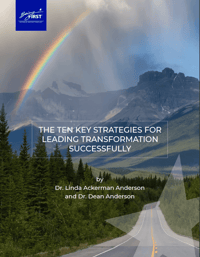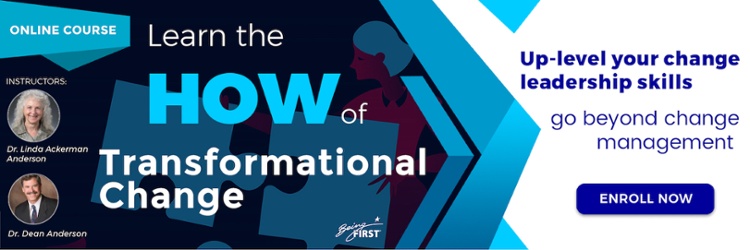Usually when leaders think about transformational change, they separate the hard, tangible aspects of the changes required, from the human or cultural aspects. The key to an effective transformation strategy is to include three critical pieces that address both the content and the people simultaneously.
The initial activity in a business transformation is usually oriented to the organizational changes that are going to drive business results. Leaders will focus on the new organizational structure or systems, business processes, or technology and try to, as quickly as possible, identify the design solutions for those changes. Then, once they have designed the solution, they will engage change management professionals or other organizational development professionals to help lower any resistance in the stakeholders and create commitment to the changes.
Once you have engaged in possibility thinking, crafted your vision, and identified the breakthroughs needed in business results, organization, culture, leadership, workforce performance, and change leadership capability, you then need to build a transformation strategy that enables you to achieve those breakthroughs and realize your company vision.
Why Stakeholders Resist Transformation
The problem is that resistance to change is created in large part because the stakeholders have not been engaged up front and early in the process; to provide input, line-of-sight, or insight to the organizational structure, systems, processes, and technology changes. So, the key in a transformation strategy is to conceive what we would call the content solutions and the engagement of people, together in a unified process.
Three Parts to a Successful Transformational Strategy
In any effective transformational strategy, there are always three pieces:
Content of Change
The organizational focus of the change (structure, strategy, business process, systems, technology, product, or service.
People in Change
People’s mindset, emotional reactions, behavior, degree of engagement, acceptant, commitment, and cultural dynamics.
Process of Change
The way in which change is planned, designed, and implemented, how it unfolds, its roadmap, governance, and course corrections.
Related Video:
Dr. Linda Ackerman Anderson and Dr. Dean Anderson discuss what transformation is and explore the critical areas of a transformation strategy that ensure success.
When you separate the content and the people during the process of change and put one first and the other second, you set the transformation up for failure.
Transformational leaders build a unified change process that integrates all the content changes with all the people changes so that right from the beginning, the transformation strategy is moving the dial on engagement, communications, and commitment through how their leaders are going about identifying the content solution.
That early employee engagement, communication, participation, and inputting to direction, as well as the early engagement in how you are going to change the culture, is what instills the stakeholder commitment to pursue the content changes successfully. So, what is required in the transformation strategy is to build an integrated strategy that addresses both the content and the people simultaneously. This enables you to achieve your breakthroughs and realize your organizational vision.
Related Video:
What is Transformation? What are the Critical Areas of a Transformation Strategy
Related eBook:
The Ten Key Strategies for Leading Transformation

Through 40 years of observing and supporting large-scale change and transformation in Fortune 500, government, global NGOs and public service organizations, we’ve identified these ten Best Practice strategies for leading transformation successfully.
Please complete the form to download your eBook:



